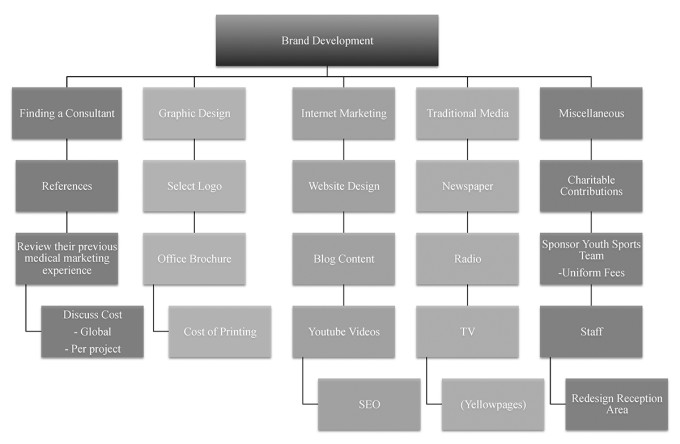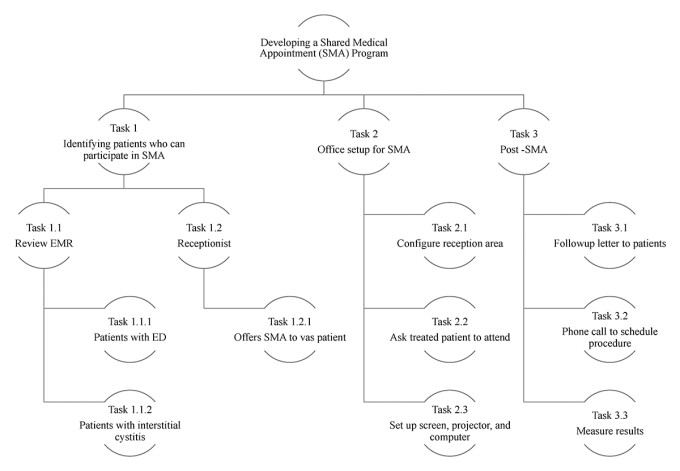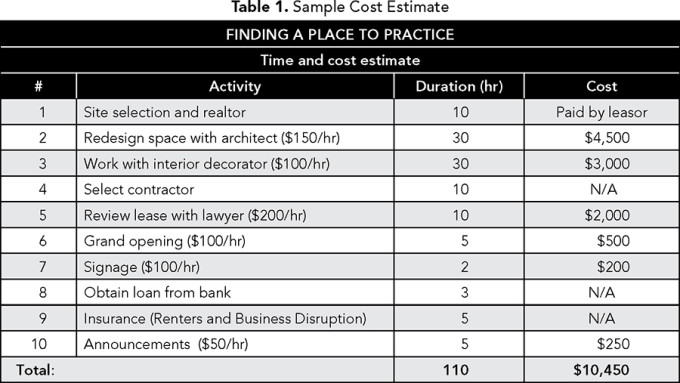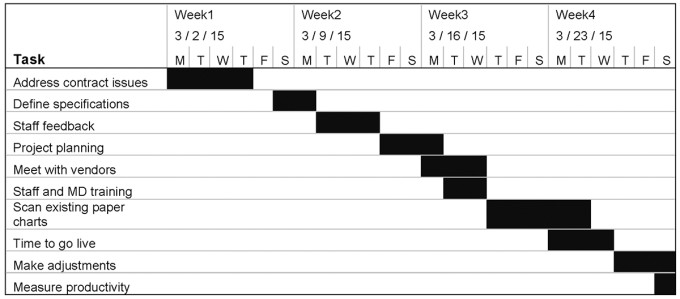Abstract:
Every medical practice and every hospital will at some point decide to incorporate a new technology, a new procedure, or a new building; hire a new doctor; or embark on literally hundreds of other projects that require going outside of the box and outside of the usual routine in order to bring the project to fruition.
Creating a timeline and a budget is an important step in implementing changes in the practice. Estimating the cost and time required from initiation to completion is a daunting challenge for any medical practice or hospital. Implementing a new project requires leaving the comfort zone of the routine in order to produce a unique product, service, or result. A project is temporary: it has a defined time to begin and end, and a projected cost. Both of these issues—time and costs—have to be estimated with a degree of accuracy in order to accomplish a singular goal.
When projects are delayed or over budget, the problems often are a result of faulty estimates for the work involved and the related costs at the beginning of the effort.(1) Therefore, it is vital to gather accurate information from the outset and prepare estimates that will make the project successful, arriving at the destination on time and within the estimated budget.
Beginners to the concept of project management often are inaccurate. The time needed for completion often is underestimated because none of the contingencies that can delay the project are taken into account, and the cost of the project often is underestimated, resulting in cost creep or going over the budget.
Time delays and cost overruns also affect the morale of the team and result in finger-pointing and playing the blame game, as no one is taking ownership or responsibility for the delays or added expenses.
Organizing a Team Responsible for the Project
A successful project such as developing a brand for the practice requires a leader who can coordinate those assigned to various tasks to see that the project is completed in a timely fashion and within the allotted budget.
If you can’t put your goal on the back of an envelope, you shouldn’t initiate the project.
One of the ways of getting everyone on the same page is to develop a project proposal and then tweak or refine it over time. The proposal should address the following elements(1):
Goal or purpose of the project;
Why the project is being implemented; and
The objectives of the project.
At this early stage, the idea for a project will be carefully examined by the team leader to determine whether or not it benefits the practice or the hospital. During this early phase, a decision-making team, usually consisting of the office manager, the doctors, and someone from marketing, will determine whether the project can realistically be completed. Ideally, the goal should be synthesized into a single sentence. We believe that if you can’t put your goal on the back of an envelope, you shouldn’t initiate the project.
Starting with a List of Tasks
Initially, the team should meet and list all of the tasks that will be needed to make the project happen. We suggest that this meeting take place away from the practice or the hospital, to avoid distractions. Of course, all cell phones must be silenced during this meeting. The leader should ask everyone for tasks that they deem necessary for the successful completion of the project. Ideas should not be judged at this time; rather, free-flowing dialog should take place, with every idea written on a white board or a flip chart. One team member should be assigned to take notes and to prepare a summary or spreadsheet of the tasks. You want to try to identify all of the activities, tasks, and duties that the project will require in as much detail as possible. Figure 1 shows tasks necessary to create a brand for a urology practice.

Figure 1. Brand development for a urology practice. SEO, search engine optimization.
Creating a Work Breakdown Structure
A work breakdown structure (WBS) is a spreadsheet of all the work necessary to complete a project. A WBS is arranged in a hierarchy and constructed to allow for clear and logical groupings, by either activities or results. The WBS serves as an early foundation for creating an effective schedule and for cost estimating. A project manager or leader will develop a WBS as a precursor to a detailed project schedule.
An example of a WBS for creating a shared medical appointment (SMA) program for the practice is shown in Figure 2. Most WBSs start with a description of the project, followed by a list of categories for accomplishing the project. These usually are the tasks that were identified at the initiation of the project. Under each category is the list of steps that must be taken to accomplish each of the categories.

Figure 2. Work breakdown structure for developing a shared medical appointment (SMA) program. ED, erectile dysfunction; EMR, electronic medical record; vas, vasectomy.
Developing an Estimated Project Cost
For each activity in the WBS you need to calculate a cost. For example, creating a logo for the brand may be a one-time cost, and you should have a range provided to you by the logo designer. However, updating and maintaining the website and other social media for the brand will be an ongoing cost that will continue after the project has been launched and also after the completion of the initial project.
Another method of assigning costs is to use historical data. If your practice or hospital has completed a similar project, such as an ad campaign to promote a service offered by the practice, the cost of the previous project may be available and may be at least partially applicable to the new project. Finally, the project manager can estimate overhead by applying a percentage based on how much overhead costs such projects typically generate.
A common technique for cost estimating is to list the resources you need for the project and then total their costs. If you have created a comprehensive WBS that includes all of the activities necessary for the project to be accomplished, then assigning personnel and costs to each activity becomes easier and provides the practice and the bean counters with a very close estimate of the costs involve. Typical resources include equipment, material, services, and labor. You can get costs for equipment, material, and services by consulting price lists or by requesting bids for the larger-cost items. Labor costs usually are computed at an hourly rate, and you can base the total costs on estimates from similar projects or ask for bids if you decide to outsource the work.
After preparing the WBS, you will need to assemble your team and ask them for their estimates of how much time will be required to complete their part of the project. We suggest that you ask them for a range, in hours or weeks or months, of the time they will need to create their component of the project. Using estimated hours is usually the best approach for smaller projects.
Your WBS will be essential in estimating the cost of the project. You will assign a dollar value to each of the action steps and for each category. You then add all of the costs for each category to arrive at an estimate of the total cost of the project. Table 1 shows an example of a cost estimate for finding a place to practice.

Think of your WBS as a farmer’s fence (i.e., always under construction). It is never a document set in stone. It will need to be tweaked and altered as the project evolves.
Creating a Time Line or Schedule for the Project
Two key features of a successful project are bringing the project to completion: (1) on time; and (2) within the allotted budget. Delay in time or budget overruns can wreak havoc with a project and result in even the best-intentioned project becoming derailed or even aborted. The project manager can only fulfill the desired objectives if the estimates leading to the project schedule and budget are accurate. Methods for estimating project times and costs focus on simplifying the process and breaking it down into little steps. Such methods allow project managers to estimate the cost and duration of small tasks more reliably.
Each project should have a formal schedule that will serve as a guideline for completion of various aspects of the project. This might include time to assemble the team, time to create a budget, time to develop a website, and time to generate publicity for the project. Establishing a project management schedule involves listing milestones, activities, and deliverables with intended start and completion dates.
Numerous software programs are available that easily create a project schedule. One of the more popular scheduling programs for project management is the Gantt chart, a type of bar chart that illustrates a project schedule. Gantt charts illustrate the start and finish dates of the project. A sample Gantt chart for implementing an electronic medical record system is shown in Figure 3. The bars to the right of the activity indicate when the activity will take place, and the rightmost bar in the Gantt chart indicates when the project will be completed.

Figure 3. Sample Gantt chart for electronic medical record implementation. Black squares indicate when task is completed.
It is necessary to obtain buy-in from the team responsible for the project. Once the project is finalized and the WBS is created with a budget and a time line, the team must be apprised of the expectations and their commitment to seeing that the project reaches completion must be obtained. Frequent progress reports are essential to the success of the project. You will want to ask what was accomplished in the past week and what are the plans and expectations for the next week. It is a good idea to ask if there are obstacles standing in the way of completion of the project and what can be done to remove these roadblocks. Upfront commitment and frequent communication, both written and verbal, are necessary for a successful project completion.
Summary
Doctors and practices are getting more sophisticated in their allocation of time and money for new projects. Over the lifetime of most physicians, there will be projects that will require careful planning and budgeting in order to determine the time to bring a project from idea to actual implementation. Also, it is important to have an estimate on the expenses for each project. By following the process of project management, these new ventures can be brought online in a timely fashion and within the allotted budget.
Reference
Anderson MA, Anderson E, Parker G. Operations Management for Dummies. Hoboken, NJ: John Wiley and Sons; 2013.
Topics
Systems Awareness
Environmental Influences
Related
After Shutdown, Federal Employees Face New Uncertainty: Affording Health InsuranceHow to Use Gamification to Engage Your TeamFinancial and Economic Issues

